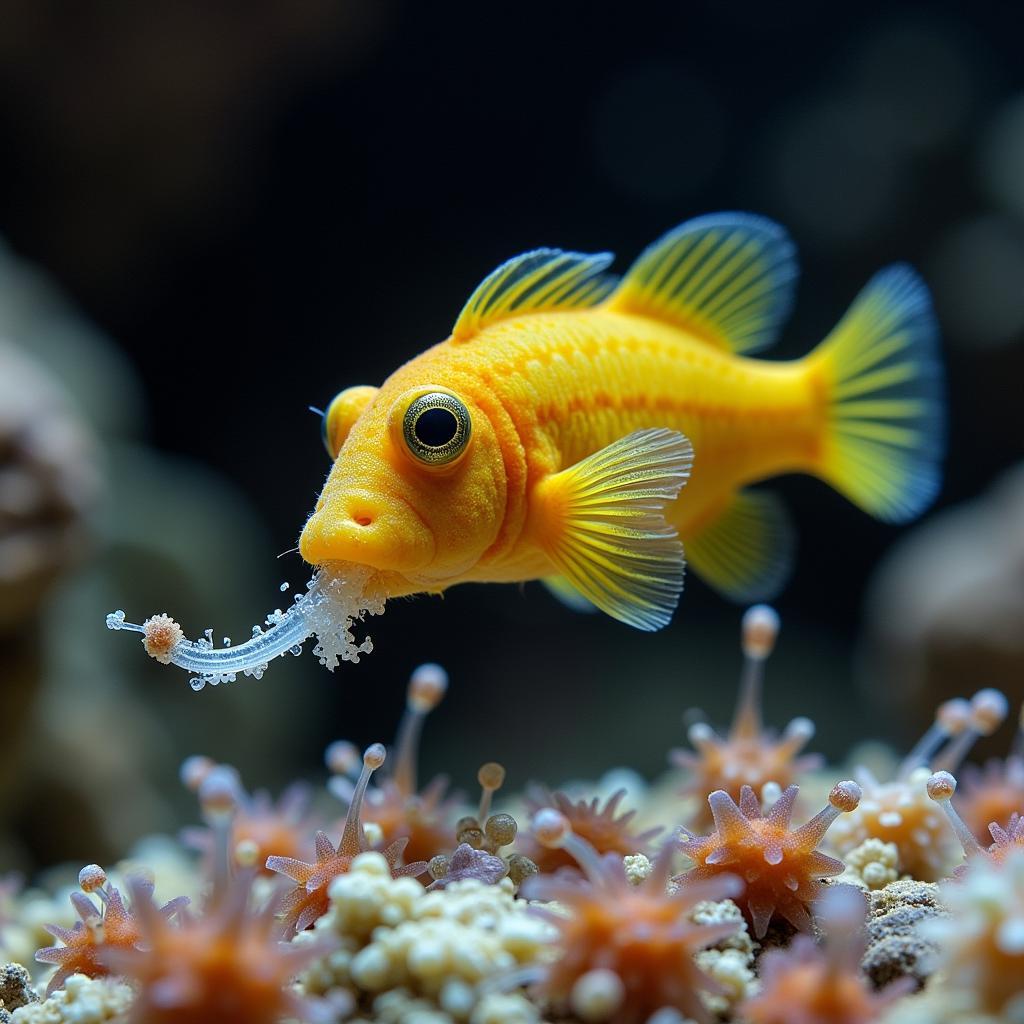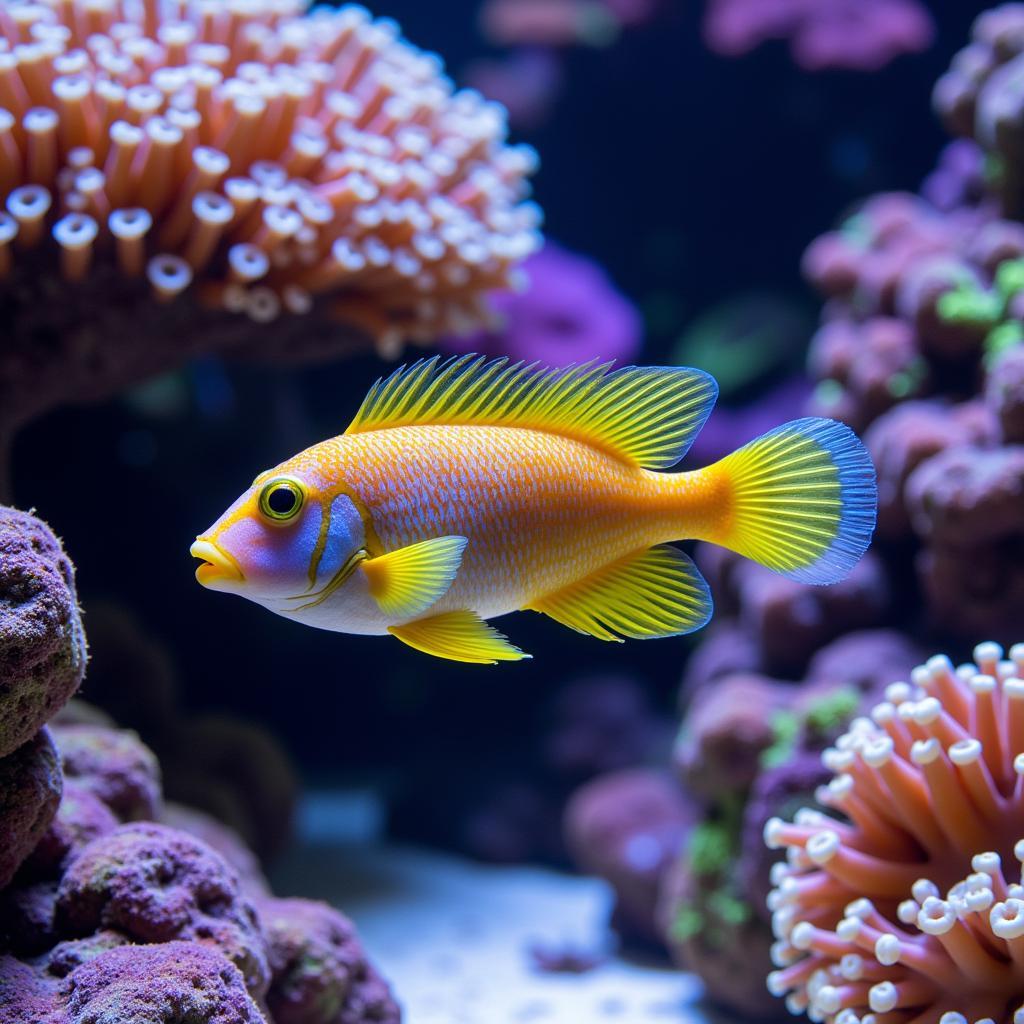Mandarin Goby Food is a fascinating topic for any marine aquarium enthusiast. These vibrantly colored fish are a popular addition to reef tanks, but their unique dietary needs can be a challenge for even experienced aquarists. Understanding what mandarin gobies eat in the wild and how to replicate that diet in captivity is essential for their health and longevity.
What Do Mandarin Gobies Eat?
Mandarin gobies, also known as Synchiropus splendidus, are small, benthic fish native to the Pacific Ocean. In their natural habitat, they are meticulous hunters, constantly grazing on small invertebrates living within the coral reef. Their diet primarily consists of copepods, amphipods, and other tiny crustaceans. They also consume small worms, fish eggs, and other microfauna found within the live rock and sand bed. Unlike many other fish, mandarin gobies don’t typically eat prepared foods like flakes or pellets.
Understanding the Mandarin Goby’s Specialized Diet
The mandarin goby’s elongated snout and small mouth are specifically adapted for picking out these tiny prey from the reef. They are not equipped to handle larger food items, and their digestive system is geared towards processing small, live food. This specialized diet is the main reason why keeping mandarin gobies can be challenging.
 Mandarin Goby Eating Copepods in a Reef Tank
Mandarin Goby Eating Copepods in a Reef Tank
Replicating the Natural Diet in a Home Aquarium
Successfully keeping mandarin gobies requires establishing a thriving population of copepods and other microfauna in your aquarium. This can be achieved through a mature refugium, regular additions of live copepods, and a healthy, established sand bed and live rock. A refugium is a separate tank connected to the main display tank, providing a safe haven for copepods to reproduce without predation.
How to Feed Mandarin Gobies in an Aquarium
While a thriving ecosystem is the ideal way to feed mandarin gobies, it’s not always immediately achievable, especially in newer tanks. Several methods can help bridge the gap and ensure your mandarin goby gets enough to eat.
Live Copepods and Other Microfauna
Regularly adding live copepods and other microfauna to your tank is essential, especially when first introducing a mandarin goby. You can purchase these from online retailers or local fish stores. Introducing different types of copepods will provide a varied diet.
Encouraging Natural Food Sources
A deep sand bed and plenty of live rock are crucial for creating a natural food source for mandarin gobies. The live rock provides ample surface area for copepods and other microfauna to thrive, while the sand bed offers a habitat for burrowing invertebrates.
 Mandarin Goby in a Reef Tank with Live Rock
Mandarin Goby in a Reef Tank with Live Rock
Alternative Feeding Methods
If your mandarin goby is struggling to find enough food, you can try target feeding. Using a turkey baster or pipette, you can gently squirt live copepods or other suitable foods directly near the goby. This can help them acclimate to the tank and find food more easily.
Training Mandarin Gobies to Eat Prepared Foods
While challenging, some aquarists have successfully trained their mandarin gobies to eat prepared foods. This usually involves offering frozen mysis shrimp or other small, meaty foods near their preferred feeding areas.
Common Mistakes to Avoid
One of the most common mistakes is introducing a mandarin goby to a tank that is not established. Without a thriving population of copepods and other microfauna, the goby will likely starve. Overfeeding the tank can also be detrimental, as it can lead to water quality issues and negatively impact the delicate balance of the reef ecosystem.
“Introducing a mandarin goby to a new tank is often a recipe for disaster. Patience and a mature system are key to their long-term success,” says Dr. Emily Carter, a marine biologist specializing in reef ecosystems.
 Healthy Reef Tank with Thriving Copepods
Healthy Reef Tank with Thriving Copepods
Conclusion
Feeding mandarin gobies requires a dedicated approach and a deep understanding of their unique dietary requirements. By replicating their natural diet and providing a thriving reef environment, you can ensure these beautiful fish thrive in your home aquarium. Remember, patience and a mature system are crucial for success with mandarin goby food and care.
FAQs
- How long can a mandarin goby go without food? A healthy mandarin goby can typically survive for a week or two without food, but prolonged periods without adequate nutrition will weaken them.
- Can I keep more than one mandarin goby in the same tank? It is generally not recommended to keep multiple mandarin gobies in smaller tanks due to competition for food.
- What are the signs of a healthy mandarin goby? A healthy mandarin goby will have vibrant colors, a rounded belly, and an active feeding behavior.
- How often should I feed my mandarin goby? In a well-established tank with a thriving population of copepods, supplemental feeding may not be necessary. In newer tanks, regular additions of live copepods are crucial.
- What size tank do I need for a mandarin goby? A minimum tank size of 30 gallons is recommended, but larger tanks are preferred to provide ample space and a more stable environment.
- Can I keep a mandarin goby with other fish? Yes, mandarin gobies are generally peaceful and can be kept with other non-aggressive reef fish.
- What is the average lifespan of a mandarin goby in captivity? With proper care and a suitable diet, mandarin gobies can live for 5-10 years in a home aquarium.
“Providing a varied diet of live copepods and other microfauna is essential for maintaining the vibrant colors and overall health of a mandarin goby,” advises Dr. Michael Reed, a veterinarian specializing in aquatic animal health.
“Observing your mandarin goby’s feeding behavior is crucial for understanding their individual needs and ensuring they are getting enough to eat,” adds Dr. Sarah Jones, a marine biologist with expertise in fish behavior.
Need support? Contact us at Phone Number: 02437655121, Email: minacones@gmail.com Or visit us at: 3PGH+8R9, ĐT70A, thôn Trung, Bắc Từ Liêm, Hà Nội, Việt Nam. We have a 24/7 customer service team.